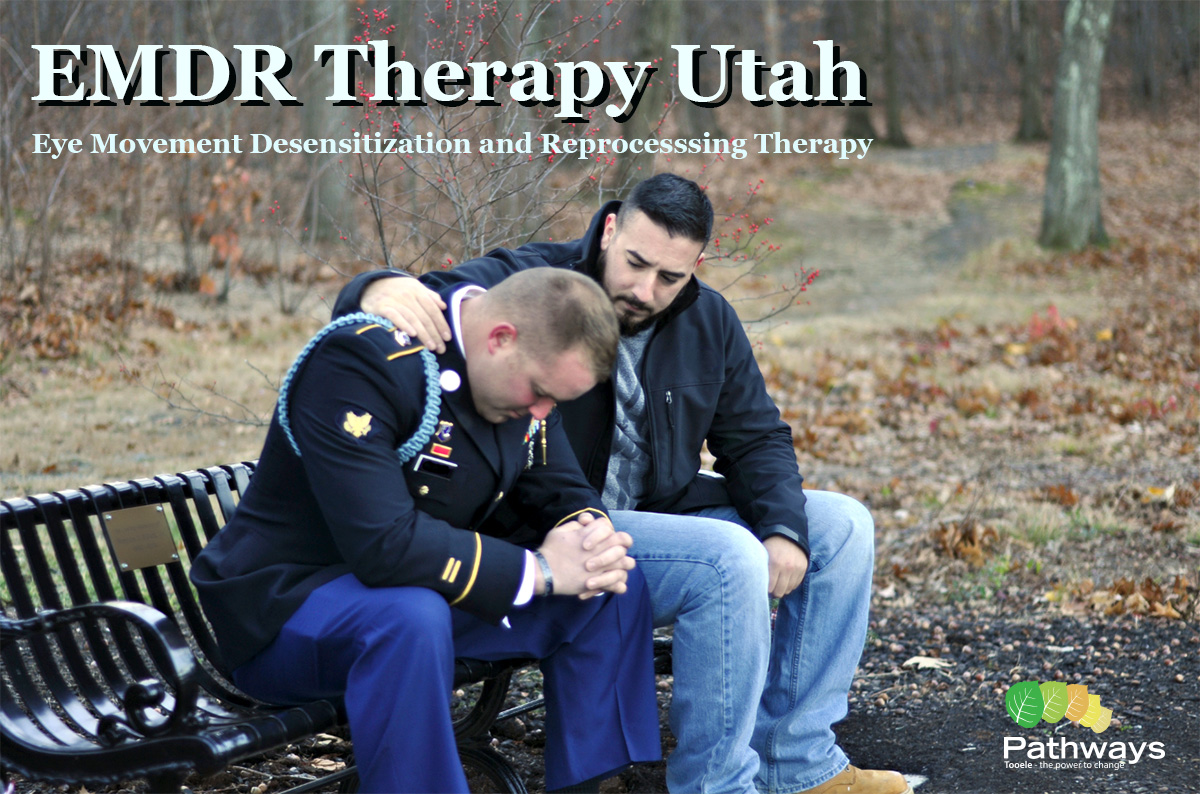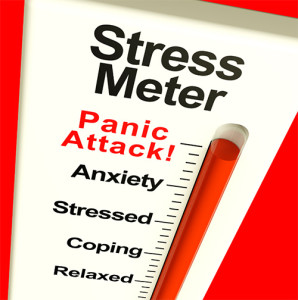
Eye Movement Desensitization and Reprocessing (EMDR) Therapy in Utah
At Pathways Real Life Recovery, we offer an effective form of treatment for psychological distress called EMDR or Eye Movement Desensitization and Reprocessing. Both the Department of Defense and the Department of Veterans Affairs recommend this treatment for soldiers suffering PTSD and other psychological problems. EMDR is an effective and rapid treatment for those suffering from traumatic events, anxiety, and phobias.
EMDR treatment is covered by most major insurance plans. We at Pathways Real Life Recovery have seen remarkable progress using EMDR on our clients. If you suffer from post-traumatic stress disorder or PTSD, anxiety, or phobias, call us today for more information about how EMDR can improve your life.
What is EMDR Therapy?
Eye Movement Desensitization and Reprocessing or EMDR is a form of therapy which treats people who have anxiety from past experiences, such as combat, rape, and other traumatic events. According to the National Center for PTSD, 50 percent of women and 60 percent men experience something traumatic in their lives. A smaller percentage of about 8 percent of the population will suffer from posttraumatic stress disorder or PTSD. According to the Anxiety and Depression Association of America, 18 percent of people within the United States suffer from anxiety disorders.
EMDR was discovered in the late 1980s by Dr. Francine Shapiro. A California psychologist with her own practice, she noticed that looking back and forth while walking seemed to have a more calming effect than simply walking in the forests. She began experimenting with her clients to see if they enjoyed the same benefits. In 1989, Dr. Shapiro published a study about EMDR. Since the initial studies, EMDR has been used to treat schizophrenia, eating disorders, depression, and sexual dysfunction. Its major benefit though is with those who suffer from anxiety and from PTSD.
How Does EMDR Therapy Work?
Experts aren’t entirely sure how EMDR therapy works because we’re still learning how our brains process our emotions and our memories. Part of what may happen simulates what occurs in REM or dream sleep where neural pathways are reformed and enable people to form new associations with the traumatic memory, thus allowing the brain to process the memory and the person to be able to move on with their lives. People with PTSD are often stuck in a type of loop, where they keep reliving the same traumatic event in their minds, or their bodies continue to react to different events the same way as if they were reliving the same traumatic event.
EMDR Therapy works by pairing memories, thoughts, feelings, and images of traumatic events with bilateral stimulation of the brain, which causes the brain to process the events instead of leaving them trapped away to gnaw at us. We then associate positive, adaptive thoughts with the trauma that affirms our strength and our resolution to survive the encounter. Instead of saying that you are worthless, you pair the negative situation with the fact you are worth something and you are strong and capable of surviving such trauma.
What Does EMDR Treat?
- Abuse – Physical and sexual abuse due to rape, childhood trauma, abusive relationships, and torture.
- Addictions Combined with PTSD — Includes drug addictions, alcoholism, sexual addictions, gambling, pornography addictions, and other types of addictions which are often caused by anxiety.
- Anger Dyscontrol or Episodic dyscontrol syndrome (EDS) which is caused by PTSD and substance abuse.
- Anxiety Disorders — Anxiety disorders due to generalized anxiety, panic disorders, and social anxiety.
- Attachment Disorder — Attachment disorder where the person suffered abuse or neglect as a child.
- Body Dysmorphic Disorder — As part of anxiety, the person is always obsessing over his or her appearance because of a perceived flaw. He or she may not want to leave the house, and may even contemplate suicide because they are worried about how they look. They may suffer from obsessing compulsive disorder, eating disorders and other anxiety disorders.
- Body Image Disturbance – Body Image Disturbance is a lot like Body Dymophic Disorder which can encompass depression, Body Dysmorphic Disorder, eating disorders, and other related anxiety disorders.
- Depression — Depression encompasses a range of symptoms including sadness, anxiety, loss of interest in things you love to do, weight gain or weight loss, overeating, social withdrawal, and other symptoms.
- Dissociative Disorders — include loss of memory in certain instances, emotional detachment or numbness, and even multiple personality disorder.
- Distress Related to Infertility — whether sudden loss of fertility or learning that one has been infertile.
- Eating Disorders — include anorexia and bulimia.
- Existential Angst — Caused by anxiety, dread, or other feelings.
- Generalized Anxiety Disorder — being worried constantly over a variety of social issues, finance, and work. You worry about things more often than not and you may suffer from problems sleeping, restlessness, difficulty concentrating, and being angry a lot.
- Insomnia — Sleep disorders including inability to sleep, waking up and not getting back to sleep, and other sleep disorders.
- Marital Discord — Fights due to complications from anxiety, depression, PTSD, and other behaviors.
- Obsessive Compulsive Disorder — A disorder where the person is caught up in constantly obsessing over thoughts, constantly performing the same actions over again, and/or behaving irrationally and creating coping behaviors toward different fears.
- Pain Disorder — Psychological trauma from chronic pain.
- Panic Disorders — Also called anxiety attacks or panic attacks, panic disorders arise from anxiety.
- Performance Anxiety — Anxiety due to speaking in front of people or doing something where others are watching you.
- Personality Disorders — Encompasses disorders such as schizoid, paranoid, antisocial, narcissistic and other personality disorders.
- Phobias — Irrational fears of people, places, or things.
- Pornography — Addiction to pornography is often caused by anxiety which needs treatment.
- PTSD — Post Traumatic Stress Disorder is a type of anxiety that is brought on by a traumatic event or injury. You can either experience the event, yourself, or witness the event to cause PTSD.
- Social Phobia — Fear of social situations and encounters.
- Trauma – Dealing with trauma due to war, accidents, neglect, sexual assault, or any other situation.

What Are the Eye Movement Desensitization and Reprocessing (EMDR) Phases of Treatment?
- Phase 1: History and Treatment Planning — Our therapists will talk with you and get a thorough history of your life and what has brought you to seek treatment. The therapist will then plan out a treatment according to your life history and situation. The therapist may explore more avenues if other issues come up during treatment.
- Phase 2: Preparation — Before you start the full treatment, the therapist will teach you positive coping mechanisms that will enable you to deal with any unpleasant feelings quickly. This helps establish trust between the client and therapist, plus gives the client a solid means of dealing with issues as they arise.
- Phase 3: Assessment — You will be asked to think about the situation and select a specific scene or image which causes your problems. You’ll be asked to come up with a negative statement of self belief, such as “I am worthless” or “I am bad.” You then pick a positive statement that refutes it such as “I am valued” or “I am good.” You’re then asked to tell us how truthful the positive statement feels and tell us how much of a reaction you had to the image while talking about it.
- Phase 4: Desensitization — After assessment, the therapist starts with your desensitization training. The therapist will have you perform a series of eye movements or he or she may guide you with other forms of EMDR stimulation. The therapist will guide you through the situations that may cause discomfort until you have no reaction or discomfort to the images or thoughts.
- Phase 5: Installation — In this phase of treatment, the therapist guides the client toward strengthening their positive beliefs about themselves. You will also learn the words “I am in control.” The therapist will work at strengthening your belief in those words. You won’t be fooled by these statements — if you think you need something like self defense classes or something else to help you stay in control, you will know you will have to take control of your life and get the proper training or help.
- Phase 6: Body Scan — The therapist will ask you, the client, to recall the triggering incident. At that point, he or she will look at you and also ask you to tell them where the stress and tightness is in your body. He or she will work with you so that the tightness is reduced and disappears.
- Phase 7: Closure — All sessions end with closure where they feel better than when they entered the session. If the treatment for a particular problem needs several sessions, the therapist will help you through self-calming exercises to ensure that you feel better when you leave that session.
- Phase 8: Reevaluation — Before every session, the therapist checks to be sure that you are less stressed than when you entered the prior session. He or she will identify if any other problems need to be addressed at the beginning. In this way, the therapist can ensure that you make progress toward eliminating your problem.
Past, Present and Future

The aim of EMDR therapy is getting you past whatever incident is causing your anxiety, PTSD, or other behavior problem. It doesn’t have a set time limit as more issues may be uncovered while undergoing therapy. Some phases go quickly; while others require several sessions.
How Many Sessions Does EMDR Therapy Take?
EMDR therapy sessions vary because each person is different. The first phase takes one to two sessions. The second phase can take on average one to four sessions. Your history and problem affects the number of sessions you need. In 80 to 90 percent of the patients in controlled studies have show that a single event or trauma can be handled and process in three EMDR sessions. Although not every traumatic event in your life needs to be processed, your own history with anxiety and other issues will determine how many sessions you need.
EMDR Therapy in Utah at Pathways Real Life Recovery
As you can see, we are quite excited over our successes with Eye Movement Desensitization and Reprocessing or EMDR. As licensed mental health professionals, we love seeing therapies have a positive influence in our clients. We are certified in EMDR therapy and our therapists at our Sandy and Tooele, Utah clinics are here to help you with EMDR. We’ve seen a lot of success with this therapy, especially in PTSD and any disorder that is caused by traumatic memories. When you get the traumatic event completely behind you, you can live a more full, productive, and enjoyable life.
You don’t have to live with paralyzingly traumatic memories that make you angry, obsessed, or dysfunctional. There are solutions to your problem. Whether you suffered PTSD from war, rape, auto accident, abuse, or another traumatic experience, we can help treat the trauma and help you put that behind you. If you suffer from depression, anxiety, OCD, addictions, phobia, personality disorders, eating disorders, insomnia, or another disorder, we can help get your life back. Eye Movement Desensitization and Reprocessing is safe and effective. No drugs are needed with this particular therapy and it will work with medications or without. The World Health Organization (WHO) recommends EMDR for teenagers, children, and adults with PTSD.
Contact us through our web form or call us at (435) 228-6967 for a free assessment.




